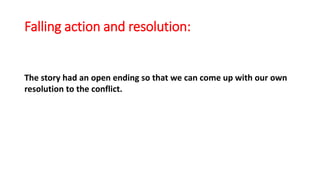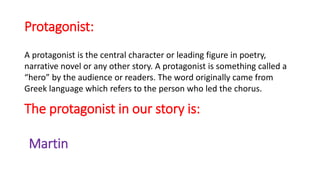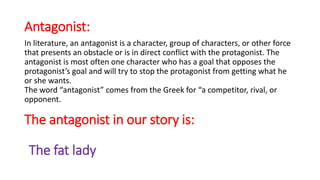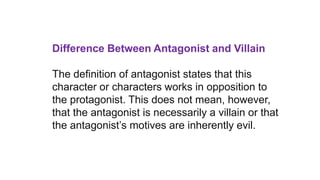The elevator analysis
- 2. Exposition: (page 31) What can you tell from the following: Martin is a twelve-year old boy who is ŌĆ£uncomfortable in elevatorsŌĆØ. (line 4) He fears that they might fall. ŌĆ£bullied at schoolŌĆØ (line 25) and ŌĆ£always picked lastŌĆØ (lines 25-26) He is not very popular with his classmates. ŌĆ£get used to itŌĆØ (line 24) He will try to deal with his fear of elevators.
- 3. State 2 external conflicts in the exposition: 1. Martin vs. his dad 2. Martin vs. the bullies at school 3. Martin vs. the elevator
- 4. What is the main conflict? The main conflict will probably involve the elevator. He has a ŌĆ£fear of being trappedŌĆØ in the elevator (lines 34-35), and he dislikes being ŌĆ£too close to any other riderŌĆØ (line 36). The storyŌĆÖs conflict will probably involve Matrin confronting his fear.
- 5. Rising action: (lines 41-174) A large woman gets on the elevator at the fourteenth floor and stares at Martin after the doors close (lines 41-49). This event forces Martin to confront his worst fears and sets the rising action in motion. State 1 internal conflict in the rising action: MartinŌĆÖs decision to either take the elevator or not.
- 6. One of the literary devices/techniques is foreshadowing which means: Foreshadowing is a hint of what is to come later in the story. It often appears at the beginning of a story, or a chapter, and helps the reader develop expectations about the coming events in a story.
- 7. Point out parts in the story where it foreshadows something.
- 8. One of the literary devices/techniques is suspense which means: The intense feeling that an audience goes through while waiting for the outcome of certain events. It basically leaves the reader holding their breath and wanting more information. The amount of intensity in a suspenseful moment is why it is hard to put a book down.
- 9. Which lines in the story helped build suspense? ŌĆó ŌĆ£blue eyes already fixed on him as though she knew heŌĆÖd be there (line 89) ŌĆó ŌĆ£it was like a nightmareŌĆØ (line 90) ŌĆó ŌĆ£The elevator trembledŌĆØ (line 94) ŌĆó ŌĆ£The fat lady watched himŌĆØ (line 95) ŌĆó ŌĆ£What was she doing? Had she been waiting for him? Was she riding with him on purpose?ŌĆØ (lines 98-99) ŌĆó ŌĆ£What is if got stuck between floors? What if it fell?ŌĆØ (line 105) Etc.
- 10. Climax: (line 175) Martin is in danger. How did we figure this out? ŌĆó The lady gets on the elevator at the tenth floor (line 172) as if she knew that Martin would be alone on the elevator at that moment. ŌĆó She ŌĆ£]moves[ in quicklyŌĆØ (line 173), as if wanting to take advantage of his vulnerability on the crutches. ŌĆó The phrase ŌĆ£the door sealed them inŌĆØ (line 174) suggests that he is trapped. ŌĆó She knows his name, she laughs, and she pushes the stop button (line 175).
- 11. Falling action and resolution: The story had an open ending so that we can come up with our own resolution to the conflict.
- 12. Protagonist: A protagonist is the central character or leading figure in poetry, narrative novel or any other story. A protagonist is something called a ŌĆ£heroŌĆØ by the audience or readers. The word originally came from Greek language which refers to the person who led the chorus. The protagonist in our story is: Martin
- 13. Antagonist: In literature, an antagonist is a character, group of characters, or other force that presents an obstacle or is in direct conflict with the protagonist. The antagonist is most often one character who has a goal that opposes the protagonistŌĆÖs goal and will try to stop the protagonist from getting what he or she wants. The word ŌĆ£antagonistŌĆØ comes from the Greek for ŌĆ£a competitor, rival, or opponent. The antagonist in our story is: The fat lady
- 14. Difference Between Antagonist and Villain The definition of antagonist states that this character or characters works in opposition to the protagonist. This does not mean, however, that the antagonist is necessarily a villain or that the antagonistŌĆÖs motives are inherently evil.

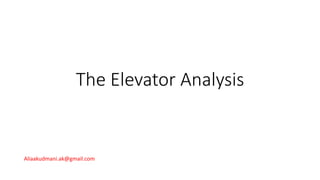
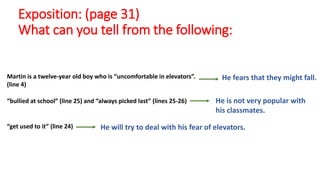
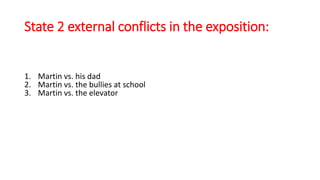
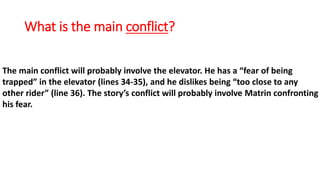
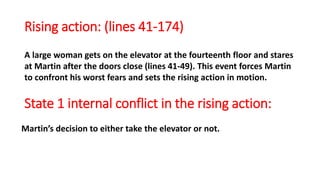


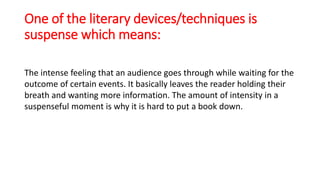
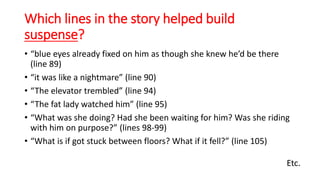
![Climax: (line 175)
Martin is in danger.
How did we figure this out?
ŌĆó The lady gets on the elevator at the tenth floor (line 172) as if she knew
that Martin would be alone on the elevator at that moment.
ŌĆó She ŌĆ£]moves[ in quicklyŌĆØ (line 173), as if wanting to take advantage of
his vulnerability on the crutches.
ŌĆó The phrase ŌĆ£the door sealed them inŌĆØ (line 174) suggests that he is trapped.
ŌĆó She knows his name, she laughs, and she pushes the stop button (line 175).](https://image.slidesharecdn.com/theelevatoranalysis-180508055731/85/The-elevator-analysis-10-320.jpg)
